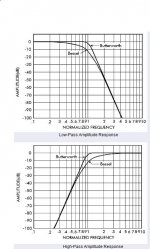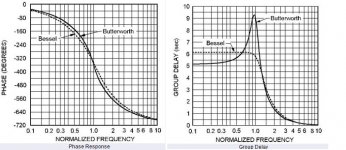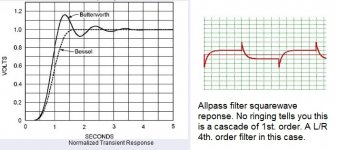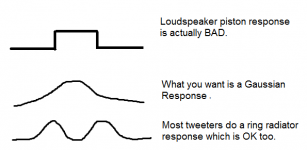I'm working on a ported sub enclosure that has a group delay peak of 32.4ms @ 20.1 hz. Is this considered excessive? Transfer function phase peaks at 179.2* @ 22.0 hz.
I've been reading some interesting articles that suggest the phase and the dalay graphs are simply two different ways to show the same characteristic of output. How audidble is this?
If I understand phase correctly, being close to 180* out of phase at 22 hz means that waveform of frequencies in that range will arrive at a later time than those at say 30* out of phase. This would mean that my perception of those frequencies would be that they were played at a lower db level, though in reality they're not. I'm wondering, could I could actually hear the difference, and what the threshold is for acceptibility of group delay/phase? Bass would sound sloppy/slow due to different frequencies arriving at different times?
Any thoughts appreciated.
I've been reading some interesting articles that suggest the phase and the dalay graphs are simply two different ways to show the same characteristic of output. How audidble is this?
If I understand phase correctly, being close to 180* out of phase at 22 hz means that waveform of frequencies in that range will arrive at a later time than those at say 30* out of phase. This would mean that my perception of those frequencies would be that they were played at a lower db level, though in reality they're not. I'm wondering, could I could actually hear the difference, and what the threshold is for acceptibility of group delay/phase? Bass would sound sloppy/slow due to different frequencies arriving at different times?
Any thoughts appreciated.
i;ve heard confilicting points of view.
view 1.) keep frequency*groupdelay < 400.
view 2.) hearing is based upon the presence of harmonics (and fundamentals), but not the phase relation for them. someone said to test this you could run a square wave input to an allpass filter and get the same sound out, despite the completely different looking waveform.
i'd try for #1 if possible.
view 1.) keep frequency*groupdelay < 400.
view 2.) hearing is based upon the presence of harmonics (and fundamentals), but not the phase relation for them. someone said to test this you could run a square wave input to an allpass filter and get the same sound out, despite the completely different looking waveform.
i'd try for #1 if possible.
I read up on group delay and phase at the Adire site as well as others. While all of them recommend minimizing group delay, most shy away from giving a specific limit. Consensus seems to be in the 25-30ms range for those that did offer a limit.
For grins I fabbed up a box today using specs close to those listed at the beginning of the thread. Initial impression is that there are no ill effects. I was REALLY happy with the increase in response down low, going from an f3 of 40hz to an f3 of 22.5hz. My goal was to use two drivers in a clamshell isobarik ported box for home theater. It ended up working out really well. I'ts amazing how much signal is missed that low on DVD's.
For grins I fabbed up a box today using specs close to those listed at the beginning of the thread. Initial impression is that there are no ill effects. I was REALLY happy with the increase in response down low, going from an f3 of 40hz to an f3 of 22.5hz. My goal was to use two drivers in a clamshell isobarik ported box for home theater. It ended up working out really well. I'ts amazing how much signal is missed that low on DVD's.
BUMP!
I have the same question. How audible is GD really?
Does the perception of it decrease with frequency - does it become less audible down low? Is it more critical above 40 Hz than below.
It's difficult to get deep extension to 20 Hz without getting GD that is fairly high, however I wonder if this is in fact audible, and that the focus shoud be higher up in the freq range.
Can anyone link some articles on this?
I have the same question. How audible is GD really?
Does the perception of it decrease with frequency - does it become less audible down low? Is it more critical above 40 Hz than below.
It's difficult to get deep extension to 20 Hz without getting GD that is fairly high, however I wonder if this is in fact audible, and that the focus shoud be higher up in the freq range.
Can anyone link some articles on this?
Haven't had time to read much of it/ vet it, but:
http://www.linkwitzlab.com/frontiers.htm#F
and "My earlier assumption that the group delay of a 4th order LR4 crossover at low frequencies would introduce audible distortion was not correct. Therefore I recommend not to use the LR2 crossover"
from http://www.linkwitzlab.com/filters.htm
and
"The real work that needs to be done is to refine these threshold measurements and extend them further into the low frequency region (where the worst delay occurs in speakers)" - from
http://www.trueaudio.com/post_010.htm
and from http://www.trueaudio.com/win_rc.htm :
"Group Delay Response
The time delay experienced by the audio signal between the speaker’s electrical input terminals and the acoustic output is known as the group delay. What does this mean? Well, if the group delay is large enough, it will be audible. The audible threshold for group delay is about 30 milliseconds, although lower is desirable. WinSpeakerz calculates group delay to let you know if your design is within the desired range See Figure 4 for the Titanic system group delay (blue plot). As you can see, our example has a maximum group delay at 23 Hz of 9.2 milliseconds.
Phase Response
The difference in phase between the input of the speaker and the speaker’s output is known as the phase response of the system. The phase response of a system should produce a smooth curve with not much in the way of large humps. This would indicate that the group delay is large, approaching the audible limit. Again for our example, the response is smooth, as would be expected by the system’s low group delay (Figure 4, purple line)."
and discussion thread:
http://www.pesupport.com/cgi-bin/config.pl?read=193185
and
http://www.diyaudio.com/forums/showthread/t-39167.html
and
A study of the audibility of different bass alignments by Ingvar Ohman:
http://www.sonicdesign.se/optimum.html
Rod Elliot:
http://sound.westhost.com/pcmm.htm
from Speaker Builder Magazine:
http://www.libinst.com/tpfd.htm

http://www.linkwitzlab.com/frontiers.htm#F
and "My earlier assumption that the group delay of a 4th order LR4 crossover at low frequencies would introduce audible distortion was not correct. Therefore I recommend not to use the LR2 crossover"
from http://www.linkwitzlab.com/filters.htm
and
"The real work that needs to be done is to refine these threshold measurements and extend them further into the low frequency region (where the worst delay occurs in speakers)" - from
http://www.trueaudio.com/post_010.htm
and from http://www.trueaudio.com/win_rc.htm :
"Group Delay Response
The time delay experienced by the audio signal between the speaker’s electrical input terminals and the acoustic output is known as the group delay. What does this mean? Well, if the group delay is large enough, it will be audible. The audible threshold for group delay is about 30 milliseconds, although lower is desirable. WinSpeakerz calculates group delay to let you know if your design is within the desired range See Figure 4 for the Titanic system group delay (blue plot). As you can see, our example has a maximum group delay at 23 Hz of 9.2 milliseconds.
Phase Response
The difference in phase between the input of the speaker and the speaker’s output is known as the phase response of the system. The phase response of a system should produce a smooth curve with not much in the way of large humps. This would indicate that the group delay is large, approaching the audible limit. Again for our example, the response is smooth, as would be expected by the system’s low group delay (Figure 4, purple line)."
and discussion thread:
http://www.pesupport.com/cgi-bin/config.pl?read=193185
and
http://www.diyaudio.com/forums/showthread/t-39167.html
and
A study of the audibility of different bass alignments by Ingvar Ohman:
http://www.sonicdesign.se/optimum.html
Rod Elliot:
http://sound.westhost.com/pcmm.htm
from Speaker Builder Magazine:
http://www.libinst.com/tpfd.htm

theChris said:i;ve heard confilicting points of view.
view 1.) keep frequency*groupdelay < 400.
view 2.) hearing is based upon the presence of harmonics (and fundamentals), but not the phase relation for them. someone said to test this you could run a square wave input to an allpass filter and get the same sound out, despite the completely different looking waveform.
i'd try for #1 if possible.
This is not correct. It has been prooven that we do indeed hear the harmonics phase relation to the fundamental.
Also allpassed square waves has been audible to listeners as well.
/Peter
Pan said:
This is not correct. It has been prooven that we do indeed hear the harmonics phase relation to the fundamental.
Also allpassed square waves has been audible to listeners as well.
/Peter
Peter, I assume this is research, where are the results?
Initial impression seems that it's most likely only audible around 30ms, however this relates to frequency. For LFE use it will not be as important as bass down below 40 Hz is not connected to a wider band inherent in musical signals, so for this purpose it will be "fast" enough. Above 40 Hz it is VERY easy to get low GD, well below 30 ms. Typically it would be less than 10 ms.
Audibility of group delay is fundamentally limited by 0.5 or 1 period of the frequency you consider. For 20Hz this is 25-50ms. For 1kHz its 1ms. In addition human ear temporal resolution comes into play, especially at higher frequencies, then what matters is signal envelope delays. It doesn't go below 1ms.paulspencer said:I have the same question. How audible is GD really?
Does the perception of it decrease with frequency - does it become less audible down low? Is it more critical above 40 Hz than below.
It's difficult to get deep extension to 20 Hz without getting GD that is fairly high, however I wonder if this is in fact audible, and that the focus shoud be higher up in the freq range.
Can anyone link some articles on this?
Don't have any good links handy, but this is interesting discussion http://www.trueaudio.com/post_010.htm
To avoid "slow and sloppy bass" the subwoofer needs to be time aligned with the woofer playing above it (or with it) at the crossover point.I'm about to design a subwoofer. Is it okay if the group delay is kept below the time of one cycle? I don't want slow and sloppy bass.
If the sub/top alignment is off by more than about 1/4 wavelength, frequency response dips and peaks will occur. If the woofer is late by one complete wavelength at the crossover, the summed response will be smooth, but the bass will sound "slow".
Time alignment with a ported top cabinet will require a different delay than a sealed top cabinet.
The output of a folded horn sub that has a 10 foot path length (9.944’) happens to be one wavelength behind at 100 Hz, it will acoustically sum OK crossed at that frequency, but will sound slow unless the tops are delayed by about 8.85 milliseconds, assuming the sub and the top cabinet had flat phase response at 100 Hz.
Some sub designs have erratic phase response within their passband, even though aligned at the crossover, they still may sound poor.
If the phase response simply shows a progressively increasing degree angle towards the low frequency cutoff, the bass won’t sound "slow and sloppy ".
Art Welter
An externally hosted image should be here but it was not working when we last tested it.
The grey line is the ported CSS SDX10 cabinet which I first thought of building. The yellow one is a closed CSS SDX10 cabinet. The orange line is the "top" speakers I first thought of building and the brownish line is a closed version "top" speaker.
Filters added as to keep the drivers from bottoming out. XO between subs and "top" speakers is not determined yet, just put 60Hz as an example.
Would the group delay change if I use miniDSP as XO? (which I intend to do).
All DSP has latency, but the latency is across all bands, so is not a problem.Would the group delay change if I use miniDSP as XO? (which I intend to do).
The top and bottom filters add some delay, how much depends on the particular DSP and the filters applied.
The simulations you posted (too large
Delay times can be accurately set simply using a dB meter (easier with an RTA if you have one) and a sine wave tone set at the crossover point.
Set the meter on the floor with the sub and top cabinet at equal distance to the meter, if indoors, the sub and top should be set next to each other as far away from walls as possible and the meter placed about a meter from the front of each cabinet.
With the sub speaker's polarity reversed the output between it and the top speaker will be at minimum when the delay is set properly. The sub then gets put back to proper polarity.
Care must be made that you don't set the delay an extra wavelength off, usually only a few milliseconds are required to align a front loaded ported cabinet, if you end up with 12 or 14 ms, you have delayed the tops too much.
One can physically time align cabinets using the same method, but since the sub may end up some distance closer to the mic (listener) position, best to do it outside to avoid the problem of reading reflected sound levels.
Art
Group delay is a subject I studied as an engineer on telephone and data lines and at college purely for interest. So I'll tell you what I know. 
Group delay is the rate of change of phase wrt to frequency in a channel. It describes the delay in the flow of information in a channel. Having built allpass opamp filters (which have flat frequency response but time delay), we could never actually hear ANY difference whatsoever, but it ought to be something you minimise. A filter with a high "Q" has more group delay than a filter with a low "Q". It makes sense that if energy is stored by a high "Q" electrical or mechanical filter, the time release of that energy is smeared and delayed. Ist. order RC filters introduce a constant delay at the bass end, 2nd. order allpass RCL adds a sort of ringing to the waveform.
High "Q" and steep slopes should be avoided. This equates to big closed boxes, even Acoustic Suspension, for fast bass response, and low "Q" Linkwitz-Riley filters for your crossovers. I won't opinionate about this too much, but here's the graphs. Group delay is really unavoidable in real time, but spatial filtering or digital techniques can avoid it altogether. In real time it is worth noting that smooth transitions at speaker and cabinet edges also minimise ringing.
Group delay is the rate of change of phase wrt to frequency in a channel. It describes the delay in the flow of information in a channel. Having built allpass opamp filters (which have flat frequency response but time delay), we could never actually hear ANY difference whatsoever, but it ought to be something you minimise. A filter with a high "Q" has more group delay than a filter with a low "Q". It makes sense that if energy is stored by a high "Q" electrical or mechanical filter, the time release of that energy is smeared and delayed. Ist. order RC filters introduce a constant delay at the bass end, 2nd. order allpass RCL adds a sort of ringing to the waveform.
High "Q" and steep slopes should be avoided. This equates to big closed boxes, even Acoustic Suspension, for fast bass response, and low "Q" Linkwitz-Riley filters for your crossovers. I won't opinionate about this too much, but here's the graphs. Group delay is really unavoidable in real time, but spatial filtering or digital techniques can avoid it altogether. In real time it is worth noting that smooth transitions at speaker and cabinet edges also minimise ringing.
Attachments
I should add a surprising finding from antenna theory. You actually don't want a loudspeaker that behaves as a rigid piston. The fact is a square or sharp circular aperture radiates very badly into the far field. Far better is the Gaussian aperture with a smooth rolloff at the edges. This is because the Gaussian aperture is its own inverse in the far field, so is mathematically perfect. It's the same thing of sharp transitions ring, smooth ones don't. 
Attachments
I was planning on building a measuring mic with the Panasonic WM-61A. Will that be enough to measure?
Yes
Also, is time adjustment possible with the miniDSP?
Yes, up to 7.5ms iirc.
- Status
- This old topic is closed. If you want to reopen this topic, contact a moderator using the "Report Post" button.
- Home
- Loudspeakers
- Multi-Way
- Audibility of group delay?



